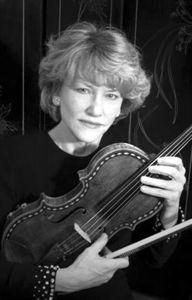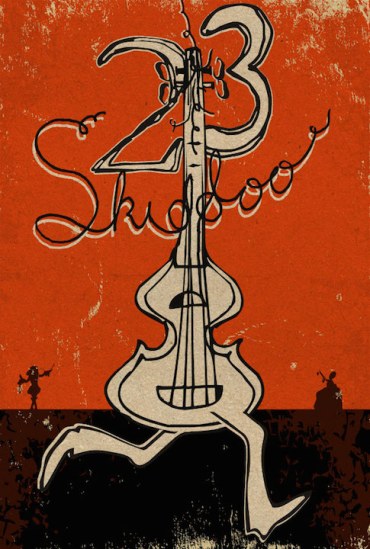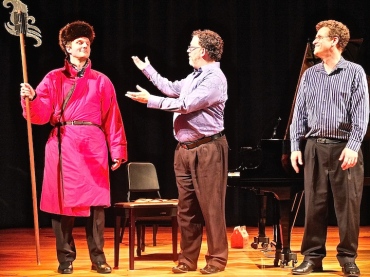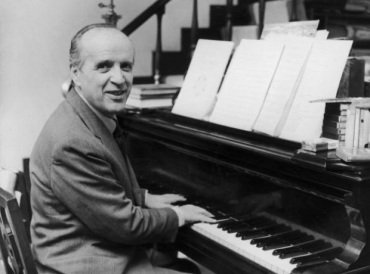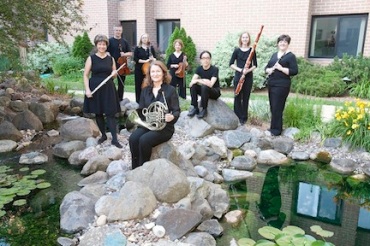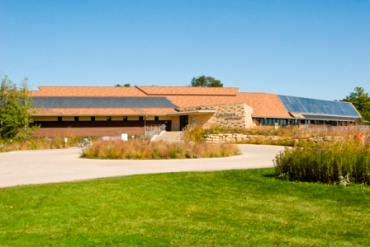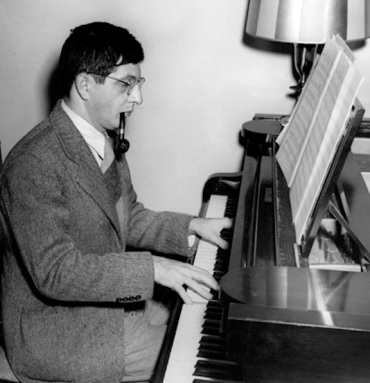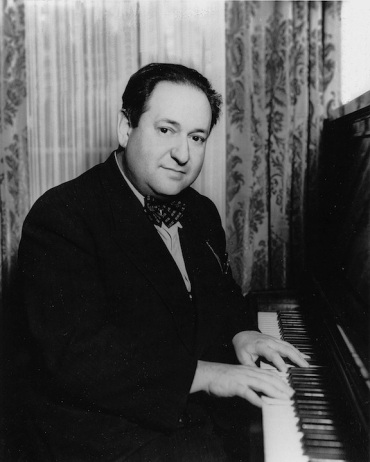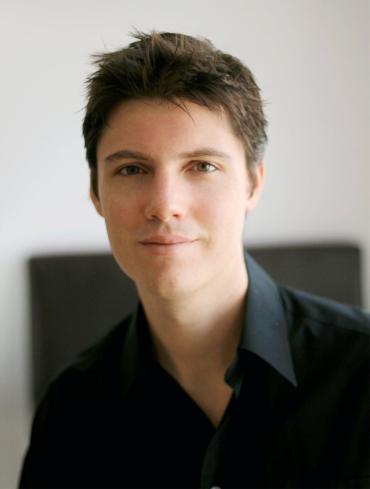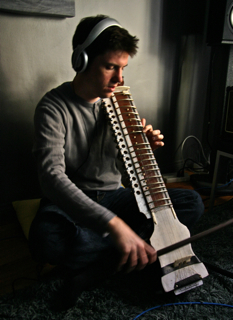The Well-Tempered Ear
Classical music: This Friday night, horn player Dafydd Bevil performs a FREE recital of music by concert-hall composers who also wrote film scores
2 Comments
By Jacob Stockinger
Attention, brass fans!
This coming night Friday, Sept. 21, at 7:30 p.m., horn player Dafydd Bevil (below) will perform a FREE recital at the First Unitarian Society of Madison, 900 University Bay Drive, in Madison.
The program features the music of composers equally adept at creating music for the concert hall or the big screen.
The program includes Fantasy for Solo Horn by Malcom Arnold; Castel del Monte by Nino Rota; Romance by Camille Saint-Saens; Elegy for Mippy I by Leonard Bernstein (heard in the YouTube video at the bottom); and the Horn Concerto by John Williams. UW-Madison graduate piano student Satoko Hayami (below) will collaborate with Bevil.
Bevil is in the process of recording an album of original works for horn written by film composers, which will be released in the spring of 2019.
While pursuing his doctoral degree at the University of Wisconsin-Madison’s Mead Witter School of Music, Bevil is currently an Associate Lecturer of Horn at UW-Whitewater; the brass section coach of the Wisconsin Youth Symphony Orchestras; and a freelance performer throughout the upper Midwest.
For further information about the performer, go to his website at: www.dafyddbevil.com.
Tags: #BigScreen, #BrassMusic, #BrassSection, #CamilleSaint-Saens, #CollaborativePianist, #CollaborativePIano, #ConcertHall, #DafyddBevil, #ElegyforMIppyI, #FilmComposer, #FilmMusic, #FirstUnitarianSocietyofMadison, #GraduateStudent, #HomeWebsite, #HornConcerto, #HornMusic, #JohnWilliams, #LeonardBernstein, #MalcolmArnold, #MeadWitterSchoolofMusic, #MovieMusic, #NinoRota, #PianoAccompaniment, #PianoAccompanist, #UniversityofWisconsin, #UniversityofWisconsin-Madison, #UniversityofWisconsin-Whitewater, #UpperMidwest, #WisconsinYouthSymphonyOrchestras, Album, Arts, big screen, brass, brass music, brass section, Chamber music, Classical music, coach, composer, concert hall, concerto, Elegy, Elegy for Mippy 1, fantasy, film, First Unitarian Society of Madison, free, freelance, graduate student, horn concerto, Jacob Stockinger, John Williams, lecture, lecturer, Leonard Bernstein, Madison, Malcolm Arnold, Mead Witter School of Music, Midwest, movie, Music, Nino Rota, Orchestra, original, performer, Pianist, Piano, piano accompaniment, Piano accompanist, recital, recording, Romance, Saint-Saens, solo, symphony, United States, University of Wisconsin-Madison School of Music, University of Wisconsin–Madison, upper Midwest, Website, Wisconsin, YouTube
Classical music: The Oakwood Chamber Players perform rarely heard repertoire this Saturday night and Sunday afternoon
Leave a Comment
By Jacob Stockinger
The Oakwood Chamber Players (below) continue their 2017-2018 season series “Journey” with a concert titled Horizon on this Saturday, Jan. 13, at 7 p.m. and Sunday, Jan. 14, at 2 p.m.
As the group often does, it will present a program of old and new works by composers who are rarely heard or performed.
Both concerts will be held at the Oakwood Center for Arts and Education, 6209 Mineral Point Road, on the city’s far west side near West Towne Mall.
Tickets can be purchased with cash or personal checks at the door: $25 for general admission, $20 for seniors and $5 for students. Visit www.oakwoodchamberplayers.com for more information.
Sunset 1892 by Michael Mikulka is a musical interpretation of a painting by influential American landscape artist George Inness. (Below is another sunset painting, “Sunset Montclair – 1892,” by George Inness, whose work can be found in the Metropolitan Museum of Art in New York City.)
 The pastoral colors are represented musically in an evocative manner by the warm timbres of the clarinet and the viola interwoven with pianistic light and shadow. An emerging American composer, Mikulka (below) saw his piece win the grand prize in a 2008 competition. (You can hear it, and see the original inspiration, in the YouTube video at the bottom.)
The pastoral colors are represented musically in an evocative manner by the warm timbres of the clarinet and the viola interwoven with pianistic light and shadow. An emerging American composer, Mikulka (below) saw his piece win the grand prize in a 2008 competition. (You can hear it, and see the original inspiration, in the YouTube video at the bottom.)
Serenade for Five Instruments by Italian composer Alfredo Casella (below) was written for a music composition contest in 1927. It nimbly combines the contrasting sounds of the clarinet, bassoon, trumpet, violin, and cello. His musical style is attributed in part to the influence of his avid appreciation for visual art.
This piece was one of the composer’s favorites and is a delightful work with five short contrasting movements that range from lilting to witty to sweetly melodic. Casella studied with Gabriel Faure and was film composer Nino Rota’s composition teacher. (Rota is famous and most familiar for his soundtracks for movies by Federico Fellini, but he also composed a lot of outstanding chamber music.)
Quintet for Winds and Piano by Swiss composer Hans Huber (below) was premiered in 1918 and written for piano, flute, clarinet, horn and bassoon.
Listeners will perceive the influence of Brahms and Schumann in his Romantic style. However, Huber definitely shows individual flair in his approach. The four-movement work is spirited and captivating, and features each of the instruments over the course of the composition with an obvious talent for virtuosic piano writing throughout its entirety.
Guest instrumentalists are Jason Kutz, piano (below); Ariel Garcia, viola; and Halie Brown, trumpet.
The members of the Oakwood Chamber Players (above) are Marilyn Chohaney, flute; Nancy Mackenzie, clarinet; Amanda Szczys, bassoon; Anne Aley, horn; Leyla Sanyer, violin; and Maggie Darby Townsend, cello.
This is the third of five concerts in the Oakwood Chamber Players’ 2017-2018 season series entitled Journey. Remaining concerts will take place on March 10 and 11; and May 19 and 20.
The Oakwood Chamber Players are a group of Madison-area professional musicians who have played with other ensembles such as the Madison Symphony Orchestra and the Wisconsin Chamber Orchestra, and who have rehearsed and performed at Oakwood Village for over 30 years.
Tags: admission, Alfredo Casella, American, appreciation, Art, artist, Arts, Bassoon, captivating, Cello, Chamber music, city, clarinet, Classical music, color, Competition, composer, Composition, Concert, contest, evocative, familiar, famous, Faure, Fellini, film, flair, flute, George Inness, grand prize, horizon, Horn, inspiration, instrument, instrumentalist, Italian, Italy, Jacob Stockinger, Johannes Brahms, journey, landscape, light, lilt, Madison, Madison Symphony Orchestra, melodic, melody, Metropolitan Museum of Art, Michael Mikulka, movement, movie, Music, new, New Music, New York, New York City, Nino Rota, Oakwood Chamber Players, Oakwood Village, old, old music, Orchestra, original, outstanding, painting, pastoral, Piano, program, public, quintet, represent, representation, Romantic, Schumann, see, senior, Serenade, shadow, Sonata, Sound, soundtrack, spirit, Student, style, sunset, Swiss, Switzerland, symphony, talent, ticket, timbre, Trumpet, U.S., United States, University of Wisconsin-Madison School of Music, University of Wisconsin–Madison, US, USA, Viola, Violin, virtuosic, virtuoso, visual, visual art, west, West Towne Mall, winds, Wisconsin, Wisconsin Chamber Orchestra, witty, year, YouTube
Classical music: Door County’s Midsummer’s Music Festival hosts opening night gala is this Friday night. Performers include the Preucil Family plus David Perry and Sally Chisholm of the Pro Arte Quartet at the UW-Madison.
Leave a Comment
By Jacob Stockinger
Our friends in Door County write:
Sister Bay, Wis. – Door County’s Midsummer’s Music Festival kicks off with a gala opening night concert and celebration on this Friday night, June 12, at 7 p.m. in Juniper Hall at the Birch Creek Music Performance Center (below) in Egg Harbor.
For this special 25th anniversary season opener, the festival will welcome to the stage the talented Preucil family (below) whose story is deeply entwined in the history of Midsummer’s Music Festival.
After a special pre-concert performance by the Preucils, the renowned musicians of Midsummer’s Music will perform lovely chamber works — including the Piano Quartet by Robert Schumann that they played on their very first concert in 1991 — to celebrate the opening of this year’s Midsummer’s Music concert season. (You can hear the heartbreaking slow movement of Schumann’s Piano Quartet, played by the Beaux Arts Trio, in a YouTube video at the bottom.)
Twenty-five years ago, festival founders Jim and Jean Berkenstock invited a young couple, along with other top-flight musicians from the Midwest, to join them for the first season of the Midsummer’s Music Festival.
Walter Preucil was a cellist with the Lyric Opera of Chicago and his wife Stephanie was an accomplished violinist. Stephanie gave birth to the couple’s first child eight months before the start of the first season. Over the next several years, the couple had two more sons – Anthony and James. And the apple did not fall far from the tree. Each of the Preucil boys shared the family’s musical talent.
Walter and Stephanie have spent every summer in Door County performing with the Midsummer’s Music Festival, and their boys have become favorites of Door County audiences who have essentially watched them grow up.
Now Zachary is an accomplished cellist at age 24 and is on the cello faculty of the renowned Music Institute of Chicago. He holds a degree from the New England Conservatory of Music and recently graduated with a masters degree from the Eastman School of Music.
Eighteen-year-old Anthony has been concertmaster for the Schaumburg Youth Symphony Orchestra as well as the District 211 Honors Orchestra. Anthony was also Principal Viola for Illinois All-State Honors Orchestra. He will be attending Pennsylvania State University in the fall where he will pursue a double degree in meteorology and violin performance.
And 13-year-old James is a skilled violinist who also is the youngest member to have been accepted into the Schaumburg Youth Symphony Orchestra.
To showcase the story of a very important part of the Midsummer’s Music family, all five Preucils will take the stage and captivate the audience with a performance of the slow “Andante con moto” movement from the String Quintet in E-flat Major by Max Bruch (below).
After the special performance by the Preucils, the prestigious ensemble known as Midsummer’s Music will take the stage to present works in a program entitled “Romantic Legacy.”
The group will perform the Piano Trio by Nino Rota, famous for his film scores for Italian director Federico Fellini, with Jean Berkenstock, flute; UW-Madison professor and Pro Arte Quartet member David Perry, violin; and William Koehler, piano.
Next will be the Quintet in C Minor, Op. 54, by Robert Kahn with Elizandro Garcia-Montoya, clarinet; John Fairfield, horn, David Perry, violin; Walter Preucil, cello; and William Koehler, piano.
Closing out the program will be the Piano Quartet in E-flat, Opus 47, by Robert Schumann with William Koehler, piano; David Perry, violin (below top); UW-professor and Pro Arte Quartet member Sally Chisholm, viola (below bottom); and Walter Preucil, cello.
Following the concert, guests will have the opportunity to mingle with the Preucils, the Berkenstocks and all of the Midsummer’s Music performers at a special reception of wine and hors d’oeurves.
A selection of large photos showcasing the Midsummer’s Music Festival’s family over the 25 years will be on display.
During the reception portion of the evening, Midsummer’s Music will unveil a brand new artwork designed by Door County artist Charles “Chick” Peterson to celebrate the festival’s 25th anniversary season. Peterson is best known for his watercolor paintings and has established a world-class reputation for his maritime works. Many of his pieces depict fond memories of everyday life.
The painting will capture the collegial spirit of the Midsummer’s Music ensemble. Patrons can purchase matted copies of the limited edition print beginning June 12 and continuing through the Big Top Door County event on July 12. Proceeds will support the Midsummer’s Music mission of bringing exceptional classical music to Door County audiences at affordable prices.
Midsummer’s Music Festival features world-class musicians from organizations such as the Lyric Opera of Chicago, Pro Arte Quartet (below, in a photo by Rick Langer), Aspen Music Festival, the Chicago Philharmonic Orchestra and artist faculty from major universities.
The festival presents a series of more than 30 classical music concerts in a host of unique venues ranging from a 120-year old bay side warehouse, to a quaint community church from the 1850s, to luxury homes of private residents. Each venue exudes character and offers a distinct musical experience for the listener.
This year’s festival runs June 12 through July 14, with an additional concert series of 10 performances during the week and a half leading up to Labor Day.
Tickets for the opening night gala are $60.
For more information on the opening night gala or any of the Midsummer’s Music concerts, visit www.midsummersmusic.com or call 920-854-7088.
The Birch Creek Performance Center is located at 3821 County Road E, Egg Harbor, WI 54209.
Tags: Arts, Birch Creek Music Performance Center, Cello, Chamber music, Chicago, Chicago Academy for the Arts, Chicago Philharmonic Orchestra, clarinet, Classical music, Door County, Eastman School of Music, Egg Harbor, Federico Fellini, film, flute, Horn, ILLINOIS, Italian, Italy, Jacob Stockinger, Lyric Opera of Chicago, Madison, Max Bruch, Midsummer Music Festival, Midsummer's Music Festival, Music, Music Institute of Chicago, New England Conservatory, Nino Rota, Piano, Piano Quartet, Piano Trio, Preucil family, Pro Arte Quartet, quintet, Robert Kahn, Robert Schumann, Romantic music, Romanticism, Sister Bay, United States, University of Wisconsin-Madison School of Music, University of Wisconsin–Madison, Violin, Wisconsin, YouTube
Classical music: The Ear travels to many places and hears much exciting music, thanks to the closing chamber music concerts by the Bach Dancing and Dynamite Society. Now he can’t wait to find out about next season and then the 25th anniversary season the following summer.
2 Comments
By Jacob Stockinger
It has been a good summer for the Bach Dancing and Dynamite Society.
Make that a GREAT summer.
It was all to mark its 23rd annual season, and mark it they did, in high style.
Thanks to BDDS, I wandered far and wide without ever leaving my seat. Here is what I did last Friday and Saturday:
I went to the movies.
And I found out that after almost a century, silent movies still work their magic. In the 1916 film “The Count” actor-director Charlie Chaplin is still brilliantly funny, and provokes loud laughs and astonished admiration for his physical pratfalls, his absurd no-win situations, his precise direction, his perfect timing, his stunts and his facial expressions.
Plus, it all happened during the duo-piano score of “Le boeuf sur le toit” (The Ox on the Roof) by Darius Milhaud and played with perfect timing and image-synching by Randall Hodgkinson and Jeffrey Sykes, who played complete with popcorn and a soda.
The Ear says “Do It Again” next summer and in the future. The mixed media event was terrific and informative entertainment.
What movies I didn’t see, I heard.
Take American composer William Hirtz’s Variations for Piano-Four Hands on Themes from “The Wizard of Oz.” From the title, it sounds goofy and too pop-like. It even seems a reach to call it classical music. But it proved an undeniably and impressively virtuosic piece for the duo-pianists Randall Hodgkinson and Jeffrey Sykes.
Fun was added by the appearance of Dorothy (BDDS executive director Samantha Crownover, below top) in her ruby slippers and one of the guards of the Wicked Witch of the West. How BDDS!
I went once again to South America, the geographical center of this BDDS season.
What took me there was the music, this time the Poem for Flute and Piano by an Argentinian named Angel Lasala (below). Never heard of him. Too bad for me. But NOW I have and am glad.
I also went there specifically through the flute, which, along with the guitar, seems the instrument of choice for the southern continent. (Remember the haunting use of the flute in “El Condor Pasa” – which would have made a great solo flute encore — and other Andean folk songs.) And it was played with such complete mastery by BDDS co-founder and co-artistic director flutist Stephanie Jutt (below) that she made a wind instrument sound percussive as well as lyrical.
I went to The Land Where Unknown Music Goes.
That is how I heard a great but neglected Trio for flute, violin and piano by Italian composer Nino Rota, more famous for his scores for movies by Federico Fellini than for his own chamber music, which is quite good. (Hollywood movie scores are getting more and more validity in the concert hall. Next season the Madison Symphony Orchestra will do a program with a lot of them written by exiles from Adolf Hitler and Nazi Germany.)
It is also how I heard neglected French composer Philippe Gaubert (below) through his rarely performed “Three Watercolors” for flute, cello and piano in which Jutt’s flute tone perfectly matched the idea of watercolor transparency and watercolor sensuality.
Even such a mainstream and popular composer as Maurice Ravel became more exotic, exciting and engaging with his Sonata for Cello and Violin with violinist Axel Strauss and cellist Jean-Michel Fonteneau (both below) of the San Francisco Trio. It is fiercely difficult and thorny to play. Ravel worked on it for two years. The Ear thinks it is Ravel’s most modern and serious work, his most unusual sounding composition. So I have to listen to it again. It’s good to rediscover something old in a new way.
But I also went to the Land of Great and Unforgettable Music.
It also always good to hear familiar music and genuine masterpieces played superbly. And that is exactly what I heard in Anton Dvorak’s Piano Trio in F Minor, Op. 65, which too often takes a back seat to the more famous “Dumky” Trio.
And I don’t think I will ever hear a better performance — despite a snapped cello string that had to be replaced mid-performance — of Dmitri Shostakovich’s dark Piano Trio No. 2 in E minor, Op. 67. It was forceful, whether biting or elegiac, and so impressed the animated audience that it — and not the more timid Gaubert — should have been the concluding work on the “Cut and Run” program. (You can hear the captivating Finale in a YouTube video at the bottom.)
We are one lucky city to hear the San Francisco Trio (below) in these works. The Ear, for one, can’t get enough of the threesome.
I don’t know what else to say except that even with the main concert season over, The Ear doesn’t think he will be making a lot of vacation plans in the future if they overlap with performances by the Bach Dancing and Dynamite Society.
And he suggests that you do the same.
Tags: Adolf Hitler, Antonín Dvořák, Arts, Axel Strauss, Bach Dancing, Bach Dancing and Dynamite Society, BDD, BDDS, Cello, Chamber music, Charlie Chaplin, Classical music, Darius Milhaud, Dmitri Shostakovich, duo-piano, Dvorak, Dynamite Society, Federico Fellini, film, flute, Germany, Hollywood, Jacob Stockinger, Madison, Madison Symphony Orchestra, Maurice Ravel, movie, Nazi, Nazi Germany, Nino Rota, Philippe Gaubert, Piano, Piano Trio, Randall Hodgkinson, Ravel, Shostakovich, silent film, silent movies, Sonata, The Wizard of Oz, Violin, watercolor, William Hirtz
Classical music: The Oakwood Chamber Players end its season this Saturday night and Sunday afternoon by performing music by movie score composers, including Nino Rota, Erich Wolfgang Korngold, Bernard Hermann and Wisconsin native Ian Honeyman.
Leave a Comment
By Jacob Stockinger
Increasingly, movie scores –- at least the best and most original of them — and their composers are being recognized as a logical and legitimate extension of or integral part of classical music, a close crossover cousin or fusion genre, if you will.
Many of the best movie scores came from classical musicians who, being Jewish, had to flee Nazi Germany. Many ended up in Hollywood, and used their musical gifts to make a living even while they privately pursued their “serious” or “art” music.
That trend of rediscovering and performing such composers and works continues locally this weekend when the Madison-based Oakwood Chamber Players (below), who are musically masterful and programatically adventuresome, will present two concerts with works by famous film composers of the 20th and 21st centuries.
The concerts are on this Saturday night, May 4, 2013, at 7 p.m. at the Oakwood Village University Woods Auditorium, 6201 Mineral Point Road, and on this Sunday afternoon, May 5, at 1:30 p.m. at the UW-Arboretum Visitor Center (below).
Tickets are available at the door: $20 for general admission, $15 for seniors and $5 for students.
Visit www.oakwoodchamberplayers.com for more information.
“The Movies” concerts will explore music from a range of backgrounds — Italian, American and Austrian — and will be tied together by their composers’ love of the cinema.
Four composers will be featured during the concerts. The composers will include:
Nino Rota (below): Known for his collaboration Federico Fellini and on the Academy Award winning score for “The Godfather II”, his Nonet for Strings and Winds (at bottom in a YouTube video with Gidon Kremer’s chamber group) is a roller-coaster ride of moods.
Bernard Herrmann (below): He composed a hauntingly beautiful Quintet for clarinet and strings that will showcase this Hollywood film composer famous for his film scores, especially for Alfred Hitchcock, in “Psycho,” “Vertigo,” “Cape Fear,” “Journey to the Center of the Earth” and “Citizen Kane.”
Erich Wolfgang Korngold (below): Setting the swashbuckling tone for “The Adventures of Robin Hood” and “The Sea Hawk,” in his substantive and delightful Piano Trio Korngold shows an incredible ability to convey mood with grand gestures.
Ian Honeyman (below): Originally from the Madison suburb of Oregon, Wisconsin, and now based in Los Angeles, the 34-year-old award-winning Honeyman has written music for dozens of feature films, short films, TV shows and was a collaborative composer and arranger on the best-selling film “Pirates of the Caribbean: The Curse of the Black Pearl.”
His suite from the feature film, “Lilly the Witch: The Dragon and the Magic Book,” represents exciting work. Honeyman’s early influences include Oakwood Chamber Players violinist Leyla Sanyer. He arranged excerpts from one of his movie scores for the Oakwood Chamber Players, which will receive its world premiere next weekend.
As Honeyman told Oakwood Chamber Players flutist Marilyn Chohaney in a recent interview: “There is something about writing for a children’s adventure film that really resonates with me.” He told her that he feels writing for a fantasy film allows him lots of room to explore unusual musical genres, because the stories themselves are outlandish. The music can be more prominent than in a drama, in which a score is sometimes best when “it is not really that noticeable.”
“The Movies” concerts are part of National Chamber Music Month (NCMM), a nationwide initiative organized by Chamber Music America. For more information on NCMM, visit www.chamber-music.org/ncmm.
The Oakwood Chamber Players is a group of Madison-area professional musicians who have rehearsed and performed at Oakwood Village for 30 years.
Here is a link to the group’s website, where you can find out more and read the eomplete interview with composer Ian Honeyman:
http://www.oakwoodchamberplayers.com/index.htm
http://www.oakwoodchamberplayers.com/images/IanHoneymanInterview2013.pdf
The Oakwood Chamber Players is a professional music ensemble proudly supported by Oakwood Lutheran Senior Ministries and the Oakwood Foundation, in collaboration with Friends of the Arboretum, Inc.
Classical music: Juilliard String Quartet names a replacement for violist Samuel Rhodes who has played with the UW’s Pro Arte Quartet and who will retire at the end of this season. UW clarinetist Linda Bartley performs on Saturday night.
5 Comments
REMINDER: Saturday night at 8 p.m. — NOT Friday night as first and mistakenly stated here — in Morphy Recital Hall, UW clarinetist Linda Bartley (below) will perform a FREE concert with Jeannie Yu, piano; and Sally Chisholm, viola. The program includes “Sonata in D” by Nino Rota; “Liquid Ebony” by Dana Wilson; “Cantilene” by Louis Cahuzac and “Scarlattiana” for Clarinet, Viola and Piano by Walter Mays. Also, at 8 p.m. tonight, Friday night, in Mills Hall, the Wisconsin Brass Quintet marks 40 years with a FREE concert. For details, see Thursday’s post.
Perhaps the premiere name among American violists these days, especially for chamber music, is Samuel Rhodes (below, in a photo by Peter Schaaf).
Rhodes teaches viola, and heads the viola department, at the Juilliard School of Music, where he also has played in the award-winning Juilliard String Quartet since 1969. The influential and critically acclaimed quartet was founded in 1946. (Rhodes in on the far right.)
Rhodes has often been a guest artist with the University of Wisconsin’s Pro Arte String Quartet. Last year (below, Rhodes sitting second from right), during the celebration of the Pro Arte’s centennial, Rhodes sat in to play one of those sublime but underplayed Mozart String Quintets with two violas.
Members of the Pro Arte have always told The Ear not only how much they admired Rhodes’ playing but also how they found him a congenial colleague to work with. And so it seemed form the beautiful results one heard when they played together.
Rhodes will be replace in the quartet by British player Roger Tapping (below, in a photo by Susan Wilson), the current violist of the acclaimed Takacs String Quartet.
Here is a link to two stories, from Gramophone Magazine and The New York Times, about Tapping and Rhodes:
http://artsbeat.blogs.nytimes.com/2012/10/08/more-turnover-in-the-juilliard-string-quartet/
Here on YouTube is Samuel Rhodes playing and discussing Beethoven:






























